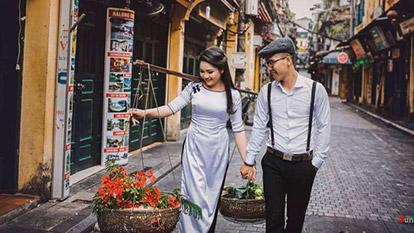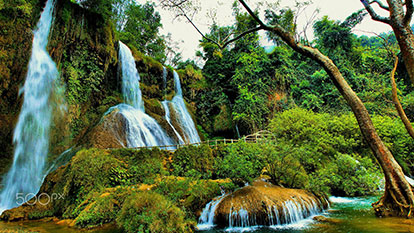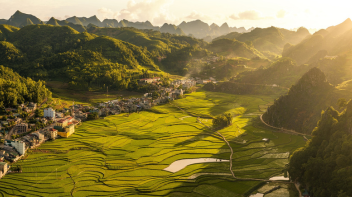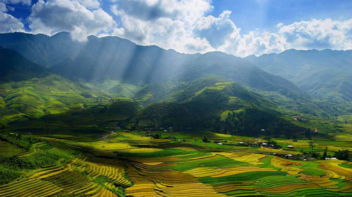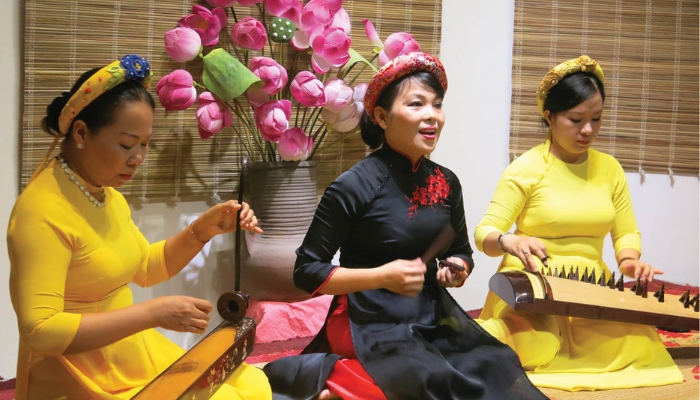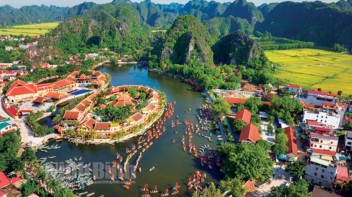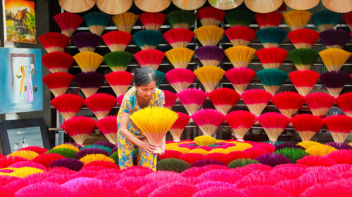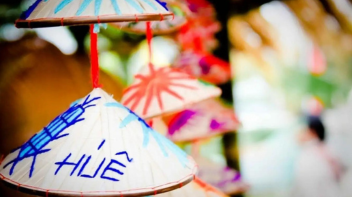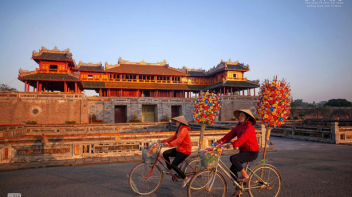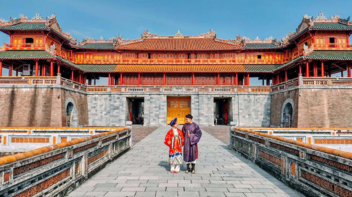Vietnam History
13/04/2019 925 Views
From the 1st to the 6th centuries, the south of what is now Vietnam was part of the Indianised kingdom of Funan. The Hindu kingdom of Champa appeared around present-day Danang in the late 2nd century and had spread south to what is now Nha Trang by the 8th century.
The Chinese conquered the Red River Delta in the 2nd century and their 1000-year rule, marked by tenacious Vietnamese resistance and repeated rebellions, ended in 938 AD when Ngo Quyen vanquished the Chinese armies at the Bach Dang River.
- During the next few centuries, Vietnam repulsed repeated invasions by China, and expanded its borders southwards from the Red River Delta, populating much of the Mekong Delta. In 1858, French and Spanish-led forces stormed Danang after several missionaries had been killed. A year later, Ho Chi Minh City (formerly Saigon) was seized. By 1867, France had conquered all of southern Vietnam, which became the French colony of Cochin-China. travel vietnam.
- Communist guerillas under the leadership of Ho Chi Minh resisted French domination. Ho Chi Minh's declaration of Vietnamese independence after WWII sparked violent confrontations with the French, culminating in the French military defeat at Dien Bien Phu in 1954.
- The Geneva Accords of 1954 temporarily divided Vietnam into two zones (the Communist north and the anti-Communist, US-supported south). Political and ideological opposition quickly turned to armed struggle, prompting the USA and other countries to commit combat troops in 1965. The Paris Peace Agreements, signed in 1973, provided an immediate cease-fire and signalled the withdrawal of US troops. Saigon eventually capitulated to the Communist forces on 30 April 1975.
- Going straight from the fat into the frying pan, Vietnam had barely drawn breath from its war with America when it found itself at loggerheads with Khmer Rouge forces along the Cambodian borders. A protracted round of fighting eventually saw China enter the fray in support of Cambodia and the killings continued until the UN brokered a deal, with Vietnamese forces being pulled out of Cambodia in 1989. Although the Khmer Rouge continued to snipe from the borders, it was the first time since WWII that Vietnam was not officially at war with any other nation. The end of the Cold War and the collapse of the USSR in 1991 caused Vietnam and Western nations to seek rapprochement.
- In July 1995 even intransigent America re-established diplomatic relations with Hanoi although the diplomatic handshake appeared limp-wristed and begrudging when Hanoi refused to sign trade agreements with the US in 1999. The US, on their part, talked about normalising relations but 25 years later there's still a lot of soul-searching, hand-wringing and post mortems going on, accompanied by a slather of angst-ridden films and a handful of unplugged guitar tunes.
- Matters aren't helped by spokespersons such as John McCain who, on a recent visit to Hanoi, talked about 'the wrong guys winning the war'. Vietnam went through something of a postwar economic boom but in recent years the economy has slowed and the country is at a crossroads, although some commentors predict it will be the next Asian 'tiger'.
Van Lang (2876 BC – 258 BC)
- At that time, the two ethnic tribes of the Lac Viet and Au Viet lived together in many areas with other inhabitants. Due to the increasing need to control floods, fight against invaders, and exchange culture and economy, these tribes living near each other tended to gather together and integrate into a larger mixed group. Among these Lac Viet tribes was the Van Lang, which was the most powerful tribe. The leader of this tribe joined all the Lac Viet tribes together to found Van Lang Nation, addressing himself as King Hung. The next generations followed in their father’s footsteps and kept this appellation. Based on historical documents, researchers correlatively delineated the location of Van Lang Nation to the present day regions of North and north of Central Vietnam, as well as the south of present-day Kwangsi (China).
- The Van Lang Nation approximately lasted from the beginning of the first millennium B.C. to the 3rd century B.C.
Au Lac (257 BC – 207 BC)
- In 221 BC, Qin Shihuangdi (Tan Thuy Hoang), King of Qin (China), invaded the land of the Viet tribes. Thuc Phan, the leader of the alliance of Au-Viet tribes was respected as the chief of the resistance war against the Tan enemy that later, in 208 BC, was forced to withdraw. With his imposing power, Thuc Phan nominated himself as King An Duong Vuong and founded Au Lac Nation with groups of Lac Viet and Au Viet tribes. In 207 BC, Trieu Da, King of Nam Viet (China), invaded Au Lac country.
- The resistance of An Duong Vuong failed soon after this invasion. As a result, the northern feudalist took turns dominating the country over the next seven centuries, establishing their harsh regime in the country and dividing the country into administrative regions and districts with unfamiliar names.
- However, the country’s name of Au Lac could not be erased from the people’s minds in their everyday life.
Van Xuan (544-602)
- In the spring of 542, Ly Bi rose up in arms and swept away the Chinese administration, liberating the territory. He declared himself King of Van Xuan Kingdom in February 544, acknowledging the national superiority complex of the independent spirits to live in eternal peace. However, the existence of Ly Bi’s administration was very brief. He was defeated by the Chinese imperial army, and the country returned to feudal Chinese domination again in 602.
- The name Van Xuan was restored only after the victory over the Han army at the Bach Dang River led by General Ngo Quyen in 938. This victory marked the end of the Chinese domination period in Vietnam.
Dai Co Viet (968 – 1054)
- In 968, Dinh Bo Linh defeated the twelve lords and unified the country. He declared himself King and named the country Dai Co Viet.
- This name remained throughout the Dinh Dynasty (968-980), Pre-Le Dynasty (980-1009) and the beginning of Ly Dynasty (1010-1225).
Dai Viet (1054 – 1802)
- In 1054, a flaming bright star appeared in the sky for many days, which was considered a good omen. As a result, the King Ly changed the name of the country to Dai Viet. This name remained until the end of Tran Dynasty (1126 - 1400).
- The name Dai Viet remained under the Le Dynasty (1428-1788) and the Tay Son Dynasty (1788-1802).
Dai Ngu (1400 – 1406)
- In March 1400, Ho Quy Ly usurped the throne of King Tran Thieu De, founded the Ho Dynasty and changed the country’s name to Dai Ngu, meaning peace in the ancient language. This name only lasted for very short time, until April 1407, when the Ming enemy invaded Dai Ngu and defeated the Ho Dynasty (1400- 1407).
- After 10 years of resistance against the Ming occupation (1418-1427), Le Loi had achieved a victorious triumph. In 1428, Le Loi declared himself King of Le Dynasty and changed the name of the country back to Dai Viet. At this time, the territory of Vietnam had expanded to the region of present-day Hue.
Viet Nam
- In 1802, Nguyen Anh claimed his coronation to become the first King Nguyen, starting the Nguyen dynasty and changing the country’s name to Viet Nam. This name was officially recognized in many diplomatic missions in 1804.
- However, the words "Viet Nam" had already appeared very early in history. In the 14th century, there was a book of code entitled "Viet Nam the Chi", edited by Doctor Ho Tong Thoc. In the book by scholar Nguyen Trai entitled "Du Dia Chi" at the beginning of 15th century; the words "Viet Nam" were repeated several times. Doctor Trinh Nguyen Binh Khiem (1491-1585) had written on the first page of his work "Trinh Tien Sinh Quoc Ngu" the following: "... Viet Nam have constructed its foundation..." The words "Viet Nam" were also found in some carved stelae of the 16th - 17th century in Bao Lam Pagoda, Haiphong (1558), in Cam Lo Pagoda, Ha Tay (1590), in Phuc Thanh Pagoda, Bac Ninh (1664), etc. In particular, in the first sentence on the stele Thuy Mon Dinh (1670) at the landmark on the border at Lang Son, it was written: "This is the gateway of Viet Nam that guards the northern frontiers..." In terms of meaning, there are many theories that prove the words "Viet Nam" are created by combining two racial and geographic elements, which is understood as "Viet people from the south".
- During the reign of King Minh Mang (1820-1840), the name of the country was changed to Dai Nam, but Viet Nam was still widely used in many literary works, civil business affairs, and social relations.
- Following the triumph of the August Revolution on August 19th 1945, which had entirely swept away Vietnamese feudal and French colonial oppression and began a new era in the country, President Ho Chi Minh proclaimed the nation’s independence and the national name Democratic Republic of Vietnam was born on September 2nd 1945. Although Vietnam suffered from war and separation in the following 30 years, the sacred words "Viet Nam" were very popularly used from the North to the South, and were deeply imprinted in the hearts of the Vietnamese people.
- Following the liberation of Southern Vietnam on April 30 1975, the entire country of Vietnam was completely unified. In the first meeting of the National Assembly of the Unified Vietnam on July 2nd 1976, the assembly decided to name the country The Socialist Republic of Vietnam. The constitution of 1980, and 1992, continued its affirmation of the country’s official name, legally and actually.
ONLY WITH US : 100 % MONEY BACK GUARANTEE within 10 days from the date of booking if not satisfied.
For further information, or simply a free quote, please contact us at any time via our email: info@galatourist.com, our experienced consultants will reply to you within 48 hours.Sincerely yours & see you soon!
GALATOURIST since 2005.
Related Articles
Coronavirus situation by traveller in Vietnam on February 4, 2020
Coronaviruses are a large family of viruses, which cause illnesses ranging from a simple cold (some seasonal viruses are coronaviruses) to more severe conditions such as MERS or SARS. The virus identified in Wuhan in December 2019 is a novel coronavirus. It was named 2019-nCoV.
Top 29 best places to visit in Hanoi Vietnam
As the capital of Vietnam, Hanoi still retains its leisurely pace in a quiet atmosphere compared to the more bustling Ho Chi Minh City. However, Hanoi deserves to be the capital of Vietnam thanks to its typical culture accumulated along the passage of time which defines best what Vietnam is. The article will show you 29 best places to visit in Hanoi for your choices.
Admire the majestic but charming beauty of Dai Yem Waterfall in Moc Chau
Located in the heart of Moc Chau, Vietnam, Dai Yem Waterfall is a must-visit for nature lovers and adventure seekers alike. Known for its breathtaking beauty and tranquil surroundings, this hidden gem is the perfect escape from the bustling city life. If you're wondering what to do in Moc Chau, Vietnam, a trip to Dai Yem Waterfall should be at the top of your list. In this article, we'll explore the best ways to experience this natural wonder and share tips for making the most of your visit. Stay tuned to the Vietnam travel blog by Galatourist for more insights!
Activities in Ha Giang Viet Nam: Meo Vac Town what to do
Meo Vac, located in Ha Giang, Vietnam, is a stunning location renowned for its imposing limestone cliffs, magnificent scenery, and diverse ethnic cultures. Meo Vac, which is tucked away in the untamed mountains of northern Vietnam, gives daring visitors the chance to take in the breathtaking scenery and the lively local way of life. Here are the suggestions for Meo Vac Town what to do.
Ha Giang 1 day tour: What to do for a day tour in Ha Giang Loop
Are you up for an exciting journey through the best-kept secret in Vietnam? When you come on our Ha Giang 1-Day Tour in Ha Giang Loop, you can expect to be astounded by the stunning scenery and fascinating cultural experiences that lie ahead of you.
Hue night acitivities with experiencing Hue Folk Songs on Perfume River
Hue's folk music offer one of the most captivating ways to discover the spirit of the city's cultural tapestry. Let's explore the enchanted evening pursuits this culturally diverse city has to offer.
Specialties Ninh Bình ? What to eat in Ninh Bình
Ninh Bình specialties can be an exemple for a trip of streetfood because the term "What to eat in Ninh Bình" is really curious for the touristes who traveled here
Hue Handcraft Discovery: Thuy Xuan Incense Stick-making Village (Thuỷ Xuân)
One of the most alluring Hue tourist attractions is Incense Villages like Thuy Xuan Incense Stick-making Village (Thuỷ Xuân). This is where you may capture a ton of gorgeous pictures and learn about the art of creating incense sticks. Hue has long been known for its rich cultural and historical past as well as its distinctive craft villages, the most well-known of which is Thuy Xuan Incense Village (Thuỷ Xuân) in Hue, which is said to contain the essence of this historic capital. With vibrant and eye-catching incense bundles, Thuy Xuan Village (Thủy Xuân) maintains a nostalgic charm that is alluring even though it isn't very busy or exciting.
Hue itinerary with traditional handcraft: Phu Cam Conical Hat Village
Hue conical hat or Phu Cam Village (Phú Cam) is not only elegant in shape but also subdued in colour. It appears to be piercing through light since it is so thin and light. If you plan for a Hue day tour and wonder about things to do for a day in Hue, Phu Cam Village is a highly recommended place to visit.
Best ways to get to Hue: From all parts of Vietnam for Hue itinerary
Located in the centre of Vietnam, between the well-known cities of Hanoi, Hoi An and many other Vietnam famous tourist destinations, is the lovely city of Hue. It's a must for travellers nationwide and a wonderful place to spend a Hue Vietnam tour. There are numerous ways to get Hue from all parts of Vietnam. From Hanoi, Sapa, Ninh Binh, Hoi An, Ha Long Bay, Da Nang, Sai Gon, and Phu Quoc, you can easily travel to Hue and vice versa. Here is a comprehensive guide for the transport to Hue.
What to do in 3 days in Hue: Hue itinerary for culture lovers
You may explore the most fascinating Hue attractions in Hue Vietnam tour, take advantage of the nightlife, and eat a lot of the mouthwatering cuisine from Central Vietnam in just 3 days in Hue.
2 days in Hue itinerary: Comprehensively Hue what to do and see
Hue is located in central Vietnam, between the well-known cities of Hanoi and Hoi An. It's a must for travellers nationwide and a wonderful place to spend 2 days in Hue. It doesn't take long to view Hue attractions. Many people try to fit everything into one day, but for a more leisurely Hue Vietnam tour, 2 days in Hue are ideal. I suggest coming early on Day 1 and departing late on Day 2 to get the most out of your 2 days in Hue. Because of this, you’ll have plenty of time to view everything without feeling hurried.
Testimonials
The following are the real customer reviews about GalaTourist by video clips, email & feedback form, etc... please check it out!

Ms. Francesca Tronconi & Mr Vizzolini Davide (2pax) from Spain
Ms. Francesca Tronconi & Mr Vizzolini Davide from Spain, taked a Tour in Vietnam on 8.2018

Mrs & Mr. DUPUIS (2pax) from United States
Mrs & Mr. DUPUIS from US taked a vacation of THAILAND & CAMBODIA & VIETNAM 14 days on 3.2018

Mr. Jeffrey Szymanski (2pax) from United States
They taked a trip of Vietnam and Cambodia 11 days on 3.2018

Mrs Rosemary McGuinness (2pax) from Australia
Taking a trip of Vietnam & Cambodia 14 days on 26th mars 2018

Mrs Elena Maria Sanchez (2pax) from Spain
Mrs Elena Maria Sanchez from Spain taked a trip in Vietnam on 1.2016

Group Marissa (4pax) from United States
Group Marissa 4pax from USA taked a Trip in Vietnam on 2.2016

Mr Jerzy (2pax) from Canada
Mr Jerzy from Canada have traveled in Vietnam on 3.2016

Mr Ricardo Velasco (8pax) from Argentina
Sr Ricardo Velasco 8pax - Argentina taked a trip to Vietnam Cambodia Thailand on 2016.





